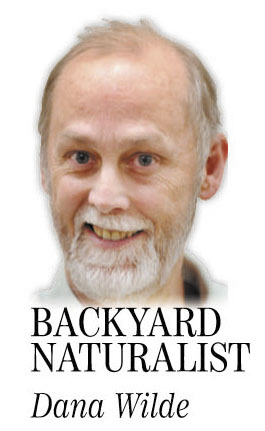North of us every night, the handle of the Little Dipper is bending around from Polaris to the stars Pherkad and Kochab on the edge of its bowl. They’ve been referred to since ancient times as “the Guardians of the Pole,” whose exact point is marked nowadays within about a degree by Polaris.
â¨Kochab is kind of an interesting star. It’s the brighter of the two guardians, at magnitude 2.08 (Pherkad’s 3.05 — the higher the number, the dimmer the star). It’s about 126 light-years from us, reddish to the eye on clear nights, and redder still in binoculars, since it’s a red giant — getting ready for the end of its long life.
â¨The Romans referred to Kochab and Pherkad as the Circlers, or Leapers, or Dancers around the pole, since the bowl of the Little Dipper wheels around Polaris once a year, and inside that yearly circle, they make a nightly circuit, like a dance.â¨
Kochab’s name, like those of many stars, is of uncertain origin. It may come from the Arabic rucaba, which in the middle ages was the name of another, dimmer star in the constellation, or from the Arabic word kaukaba, meaning star. It may also have been called in Arabic Al Na’ir al Farkadain, meaning the brighter of the two calves — the other calf being Pherkad, a shortened version of Farkadain. â¨
Farther back in antiquity, the Greeks called it Polos, or Polar Light, and astronomers farther east identified it as the mill peg.
⨔The heavens there turn around in the way a millstone does,” wrote the Greek astronomer Cleomedes around 300 BC. The mill peg epithet for Kochab could be explained in part by the fact that around 1100 BC, it actually was nearer true north than Polaris.â¨
The stars, in other words, take slow turns marking true north because the Earth wobbles on its axis, like a top wobbling as it spins. It’s called precession. One round of this wobble occurs about every 26,000 years, so the Earth’s axis, running through the North Pole, slowly points out a great circle in the northern sky. For now the top of the Earth points almost exactly at Polaris. About 3,000 years ago it was pointing roughly at Kochab.
â¨The ancient starwatchers had a kind of patience, I think, that is largely unknown nowadays. European, Arab, Roman, Greek, Egyptian, Babylonian and other adepts have tracked starlight meticulously night in and night out for a long time, at least 3,000 years and maybe much longer. They taught what they saw across generations, and some scholars think stargazers as long as 7,000 years ago — and maybe much, much longer — were encoding what they saw happening in the sky in mythological stories. It seems clear, anyway, that by the time writing was first invented around 5,500 years ago, there was enough knowledge of celestial motions to construct astronomically aligned stone rings similar to Stonehenge, which was first built around 4,700 years ago.â¨
Part of the mythological coding is this image of tremendous cosmic millstones turning in the sky over the Earth and grinding out time. But the stone of the Great Year was slipping, up there. Its central peg wheeled slowly out of joint every 26,000 years or so, wandering away to a cosmic catastrophe by flood or flame and eventually being replaced by another star-peg. That star also would slowly veer from center.
â¨In the fall, seen from my driveway, Kochab flickers rustily up there right next to my chimney. Just west of it is the star Thuban, which was in Polaris’s place about the time of the building of the Egyptian pyramids 4,700 years ago. Farther west is brighter Vega, which 12,000 years from now will be within 5 degrees of where Polaris is now.â¨
The stars look very steady from our little lifetime. But they’re like this for just a moment or two, really. The whole sky grinds on whether we’re there to watch or not, and takes us with it, every moment. If it’s not now, it is to come. If it’s not to come, then it will be now. If not now, yet it will come. The readiness is all, and the patience, which are guardians of the mind.
â¨â¨Dana Wilde lives in Troy. His writings on the stars and planets are collected in “Nebulae: A Backyard Cosmography,” available from Booklocker.com. Backyard Naturalist appears the second and fourth Thursdays each month. You can contact him at naturalist@dwildepress.net.
Send questions/comments to the editors.



Success. Please wait for the page to reload. If the page does not reload within 5 seconds, please refresh the page.
Enter your email and password to access comments.
Hi, to comment on stories you must . This profile is in addition to your subscription and website login.
Already have a commenting profile? .
Invalid username/password.
Please check your email to confirm and complete your registration.
Only subscribers are eligible to post comments. Please subscribe or login first for digital access. Here’s why.
Use the form below to reset your password. When you've submitted your account email, we will send an email with a reset code.